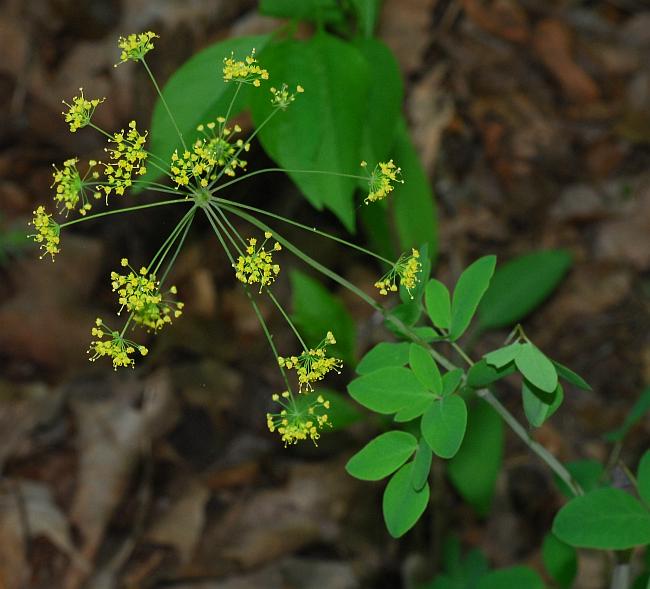Taenidia integerrima (L.) Drude
Yellow Pimpernel

Native
CC = 6
CW = 5
MOC = 73
© SRTurner
Taenidia integerrima (L.) DrudeYellow Pimpernel | |
 |
Native CC = 6 CW = 5 MOC = 73 |
© SRTurner |
|
Family - Apiaceae Habit - Perennial forb with somewhat tuberous-thickened taproots, glabrous. Stems - Ascending to erect, to 85 cm, glabrous, often glaucous, usually purple-tinged toward the base, fragrant.
Leaves - Basal and alternate, petiolate below, sessile above, the sheathing bases not or only slightly inflated, glabrous. Leaf blades 3-15 cm long, ovate or triangular-ovate to obovate in outline, ternately or pinnately 2 or 3 times compound, the leaflets 10-45 mm long, lanceolate, ovate, elliptic, or less commonly obovate, the margins entire or with 1 or 2 deep lobes (but not toothed), narrowed or rounded at the base, narrowed to a blunt or sharp point at the tip, glaucous on the undersurface.
Inflorescence - Terminal and axillary compound umbels, mostly long-stalked. Involucre absent. Rays 9-20, 0.8-8.0 cm long, glabrous, the middle ones bearing umbels of all or mostly reduced sterile flowers and shorter than those with fertile flowers. Involucel absent. Flowers numerous in each umbellet, the central ones sterile and very short-stalked, the fertile ones with stalks 5-12 mm long.
Flowers - Sepals absent. Petals 5, yellow, spreading or (more commonly) inflexed, apiculate, to 2 mm long. Stamens 5, exserted, erect to spreading. Filaments pale yellow, glabrous, to 2.5 mm long. Anthers pale yellow, 0.5-0.6mm long. Styles 2, 2 mm long, spreading and twisted, glabrous, whitish at the base, purplish near the apex. Stylopodium green, thick. Ovaries inferior, slightly compressed, glabrous, 2-locular. One seed per locule. Flowers have a tendency to be either pistillate (with fewer or no stamens) or staminate (with reduced pistil).
Fruits - Schizocarps 3-5 mm long, ovate to oblong-elliptic in outline, flattened laterally, glabrous, dark brown to nearly black, the mericarps with the 5 ribs narrow and rounded, lighter brown.
Flowering - May - July. Habitat - Prairies, glades, tops and ledges of bluffs, upland forests, savannas, rocky banks of streams and rivers, roadsides. Origin - Native to the U.S. Lookalikes - Broadly, Zizia aurea, Thaspium trifoliatum. Other info. - This species can be found across Missouri and throughout most of the eastern half of the continental U.S. It is easy to identify by its compound umbels of yellow florets, with the component umbellets pointing in all directions. The effect is often compared to a firework shellburst. Additionally, the leaves are compound but have no teeth along the margins. Bruising the foliage will release a spicy aroma similar to curry or cumin. Although there are family lookalikes with yellow inflorescences, T. integerrima is the only member with the distinctive combination of yellow flowers and oblong, toothless leaflets. Photographs taken at Matson Hill County Park, St. Charles County, MO, 5-12-2014, St. Joe State Park, St. Francois County, MO, 5-18-2014, and Little Lost Creek Conservation Area, Warren County, MO, 7-7-2020 (SRTurner). |